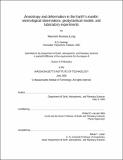Anisotropy and deformation in the Earth's mantle : seismological observations, geodynamical models, and laboratory experiments
Author(s)
Long, Maureen Devaney
DownloadFull printable version (42.76Mb)
Other Contributors
Massachusetts Institute of Technology. Dept. of Earth, Atmospheric, and Planetary Sciences.
Advisor
Robert D. Van der Hilst.
Terms of use
Metadata
Show full item recordAbstract
In this thesis I report the results of several studies of elastic anisotropy and deformation in the Earth's mantle, using shear wave splitting measurements, numerical models of geodynamical processes, and laboratory experiments on mantle minerals. I evaluate the performance of several methods for measuring shear wave splitting at broadband stations, and discuss how different measurements can inform our interpretation of mantle anisotropy. I describe a set of shear wave splitting measurements from both teleseismic and local earthquakes at 65 stations of the F-net array in Japan. I find considerable evidence from the measured splitting patterns for complex and heterogeneous anisotropy beneath Japan associated with the subduction of the Pacific and Philippine Sea plates beneath Eurasia. The comparison of teleseismic and local splitting at stations in southwestern Japan provides strong evidence for trench-parallel anisotropy in the mantle wedge above the subducting slab. I consider several scenarios that would produce the observed anisotropy and conclude that the most likely model for deformation beneath the Ryukyu arc is corner flow in the mantle wedge, with a region extending ~ 150 kilometers from the trench dominated by B-type olivine fabric. (cont.) To characterize further the detailed pattern of flow and anisotropy, I evaluate a series of two-dimensional finite element models that describe the subduction of the Philippine Sea plate beneath southwestern Japan, and compare the resulting flow field, strain, and anisotropy in the mantle wedge to F-net shear wave splitting observations. To complement this forward modeling approach, I develop and implement a method for the 2.5-D inversion of shear wave splitting intensity measurements for anisotropic structure in the upper mantle. I present preliminary anisotropic models for southwestern Japan and discuss strategies for explicitly integrating the tomographic inversion of splitting intensity data with numerical models that describe geodynamic processes in the wedge. Finally, I describe a series of laboratory experiments characterizing deformation and the resulting lattice preferred orientation in magnesiowüstite, a lower mantle mineral, and discuss the implications for the interpretation of seismic anisotropy at the base of the mantle.
Description
Thesis (Ph. D.)--Massachusetts Institute of Technology, Dept. of Earth, Atmospheric, and Planetary Sciences, 2006. This electronic version was submitted by the student author. The certified thesis is available in the Institute Archives and Special Collections. "June 2006." Includes bibliographical references (p. 289-316).
Date issued
2006Department
Massachusetts Institute of Technology. Department of Earth, Atmospheric, and Planetary SciencesPublisher
Massachusetts Institute of Technology
Keywords
Earth, Atmospheric, and Planetary Sciences.